European Travels 6 – From Lüneburg to Sylt
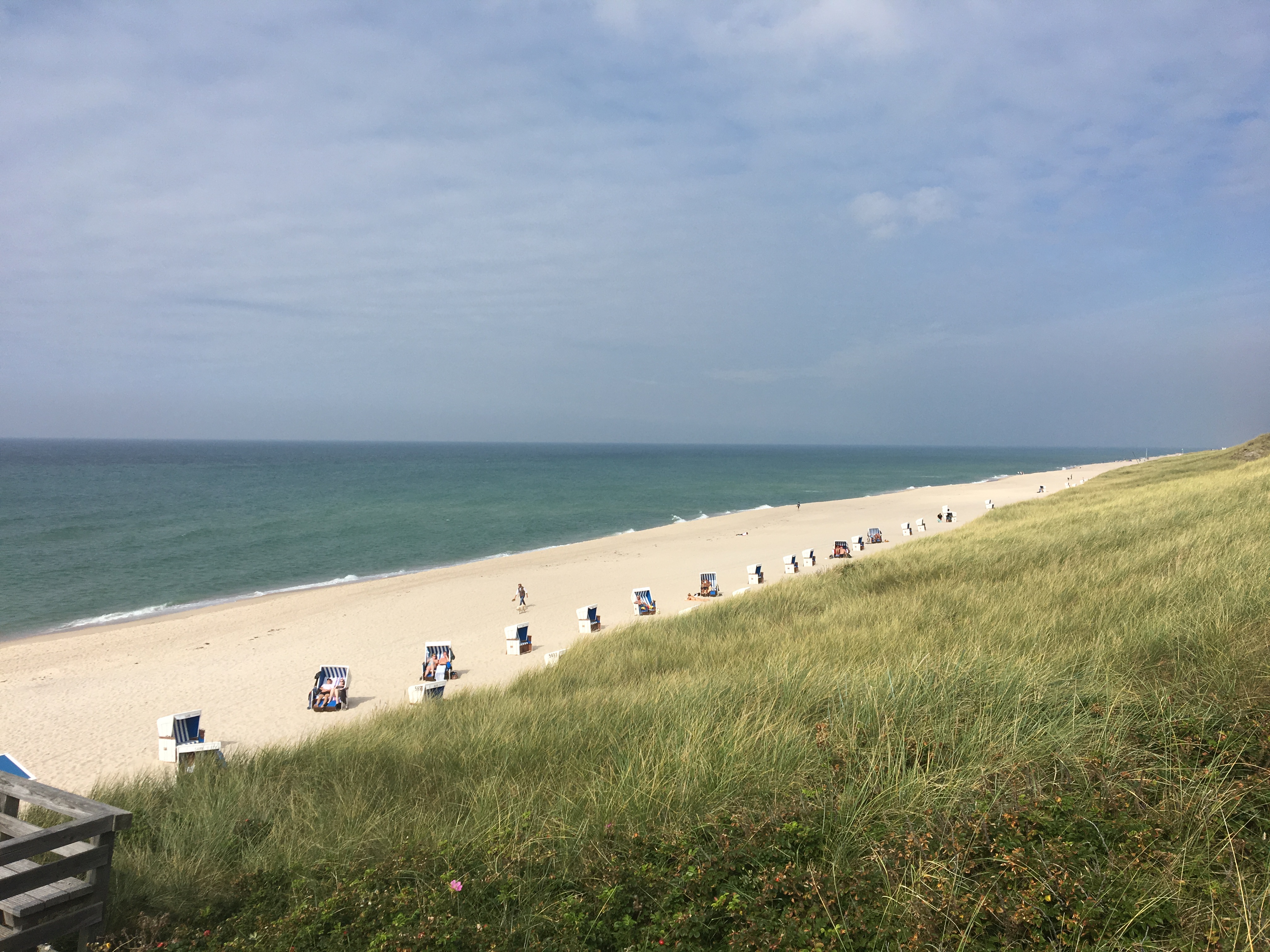 Germany's north has its own charm: off the beaten track medieval towns and sunny islands with long, white beaches.
Germany's north has its own charm: off the beaten track medieval towns and sunny islands with long, white beaches.
Readers of previous European Travels posts may remember our Canal Boating trip on Dutch canals last year.
(As last year, we again used the mywebspot pocket WIFI, which had proven so useful during our canal trip and travels to southern Germany and Austria.)
This year we again attended a family reunion in the Netherlands, with over 130 family members coming from Europe, Canada, and the United States.
Following the reunion, we went on to explore the north of Germany and Denmark, which borders Germany's most northern State, Schleswig-Holstein.
Lüneburg
From Exloo in the Dutch province of Drenthe, which lies just south of Groningen, it was only about 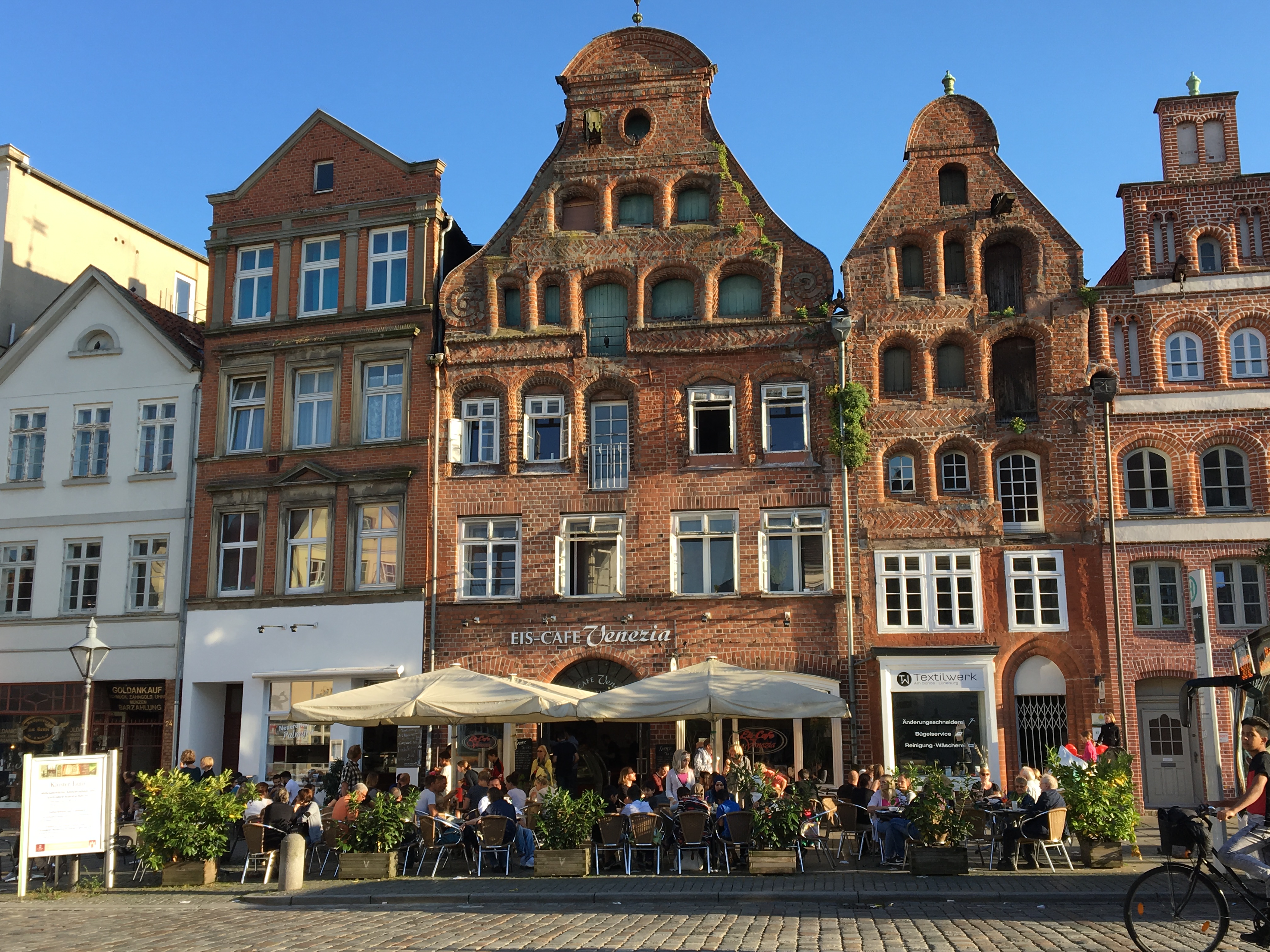 three hours by car to the town of Lüneburg (or Lunenburg), a medieval German town in the state of Lower Saxony.
three hours by car to the town of Lüneburg (or Lunenburg), a medieval German town in the state of Lower Saxony.
Located just about 30 miles southeast of Hamburg, Lüneburg is part of Hamburg's Metropolitan Region.
Since 2007, Lüneburg has been allowed to use the title “Hansestadt” (Hanseatic Town) in its name, as a reminder that it used to belong to the “Hanse” (Hanseatic League), a commercial and defensive confederation of towns and merchant guilds. (We had learned much about the Hanse while visiting Lübeck, when traveling from Hamburg to Wismar a few years ago.)
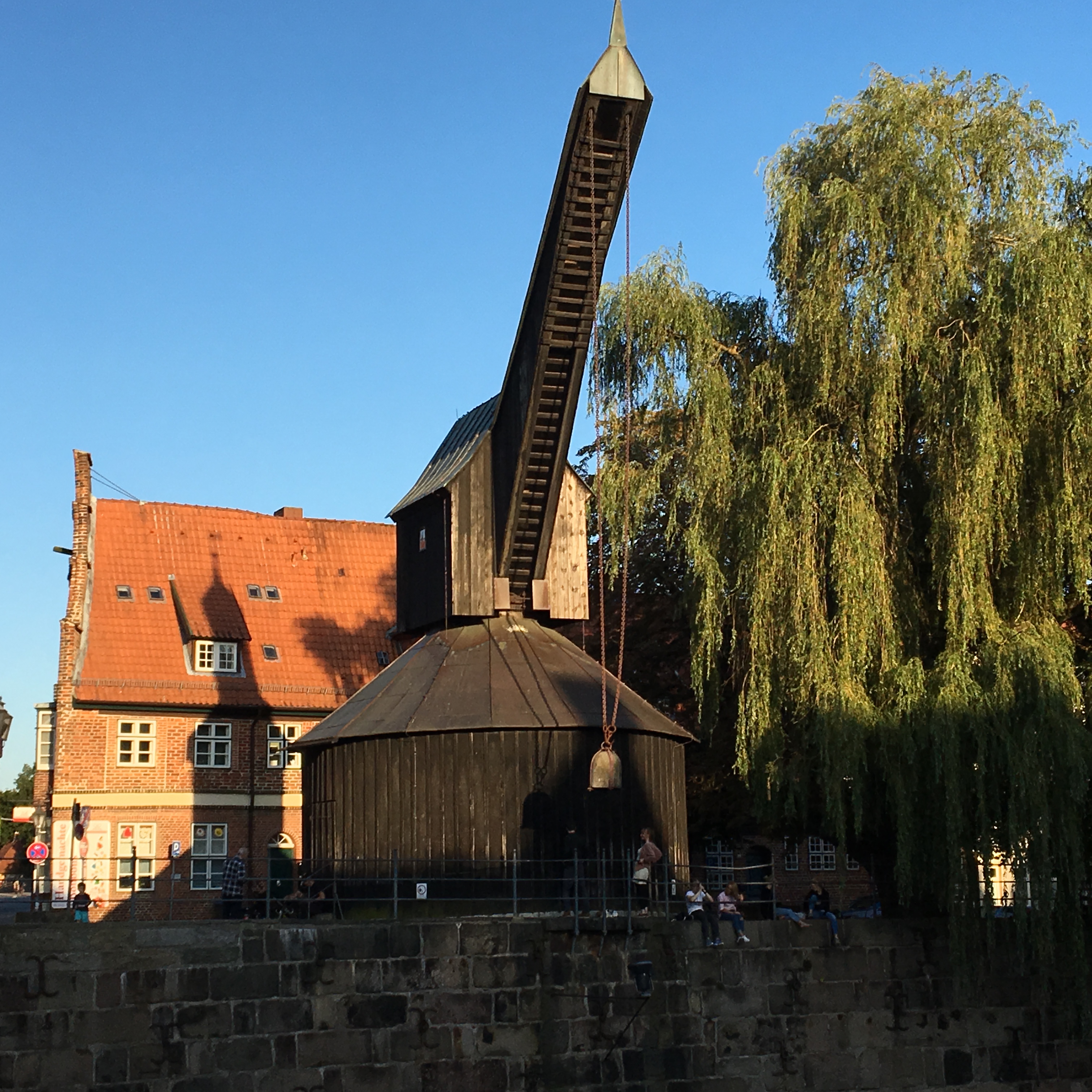 We arrived in Lüneburg on a sunny Sunday afternoon. Taking advantage of the warm September weather, we took a long, leisurely stroll through the old part of town.
We arrived in Lüneburg on a sunny Sunday afternoon. Taking advantage of the warm September weather, we took a long, leisurely stroll through the old part of town.
Lüneburg suffered little damage during the Second World War. We could thus admire many of the structures of the historical core: flower-filled alleys and courtyards, traditional gabled Brick Gothic buildings, the impressive City Hall, the huge water tower (built 1905).
The town of Lüneburg gained a great deal of wealth in the Middle Ages, when its salt springs were transformed into “White Gold”. Salt also made Lüneburg one of the wealthiest town of the Hanseatic League for many years. You can learn about salt's importance and its history in the German Salt Museum.
The “Alte Kran” (Old Crane, see picture above) which dominates the quarter along the Ilmenau Canal was used to load the salt onto the barges.
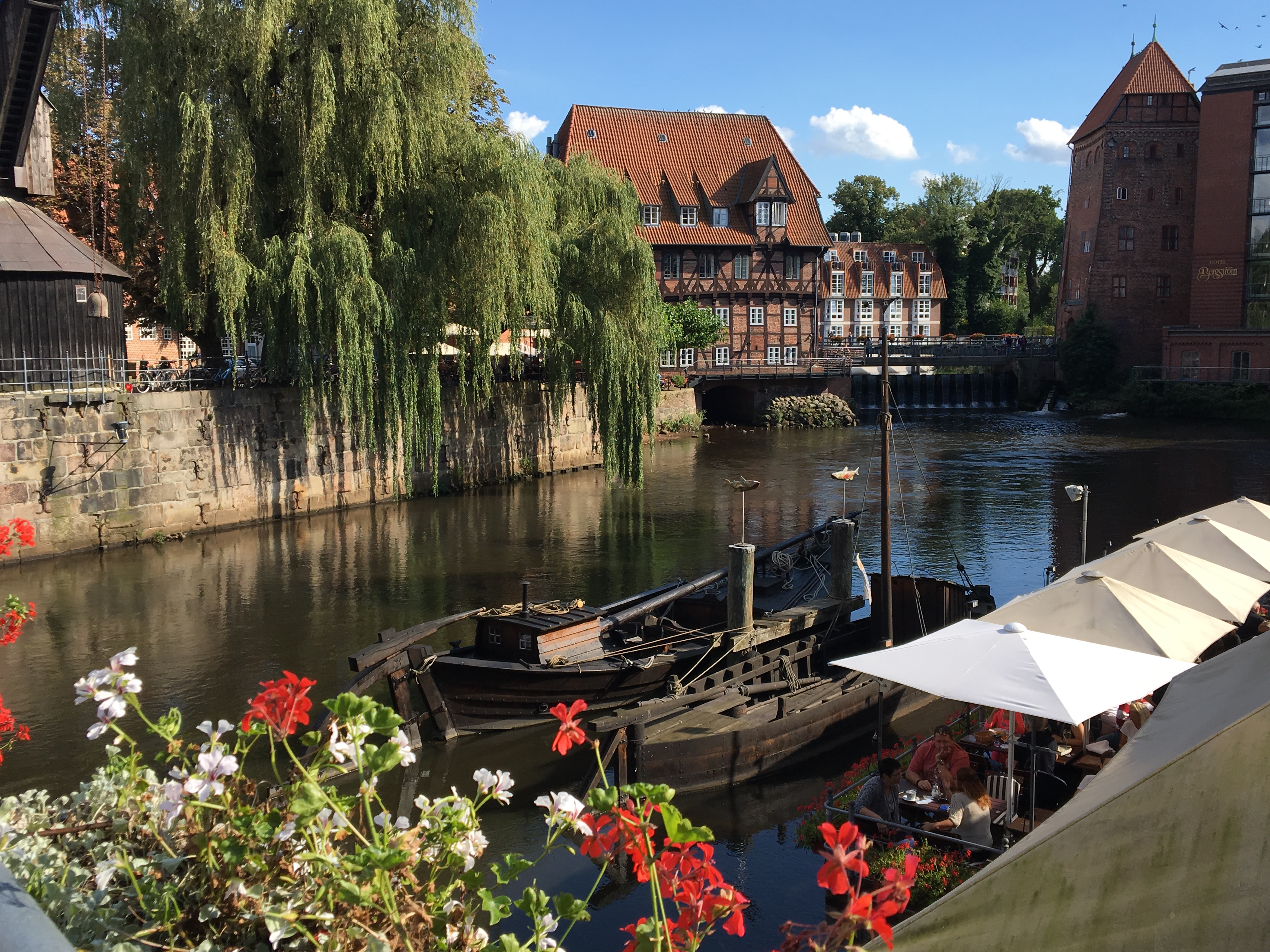 Today, Lüneburg reportedly has one of Europe's highest concentration of pubs. We certainly had no problem finding one of them with a terrace right by the canal.
Today, Lüneburg reportedly has one of Europe's highest concentration of pubs. We certainly had no problem finding one of them with a terrace right by the canal.
For German learners, the language spoken in Northern Germany is much easier to understand than the German spoken by many in the South (Black Forest, Swabia, Bavaria).
So, if you want to explore a small typical Hanseatic League town, which is a little bit off the beaten track, Lüneburg is a great choice.
If you're learning German, we've included some words and phrases to add to your vocabulary.
Vocabulary for Travelers 1
• das Mittelalter - the Middle Ages
• die Hanse - the Hanseatic League
• die Altstadt - the medieval center, old part of town
• der zweite Weltkrieg - the Second World War
• die Backsteingotik - the Brick Gothik (architecture)
• das Rathaus - the city hall
• der Wasserturm - the water tower
• das Salz - the salt
• das weiße Gold - the white gold
• der Reichtum - the wealth
• die Kneipe - the pub
• abgelegen - off the beaten track
Husum
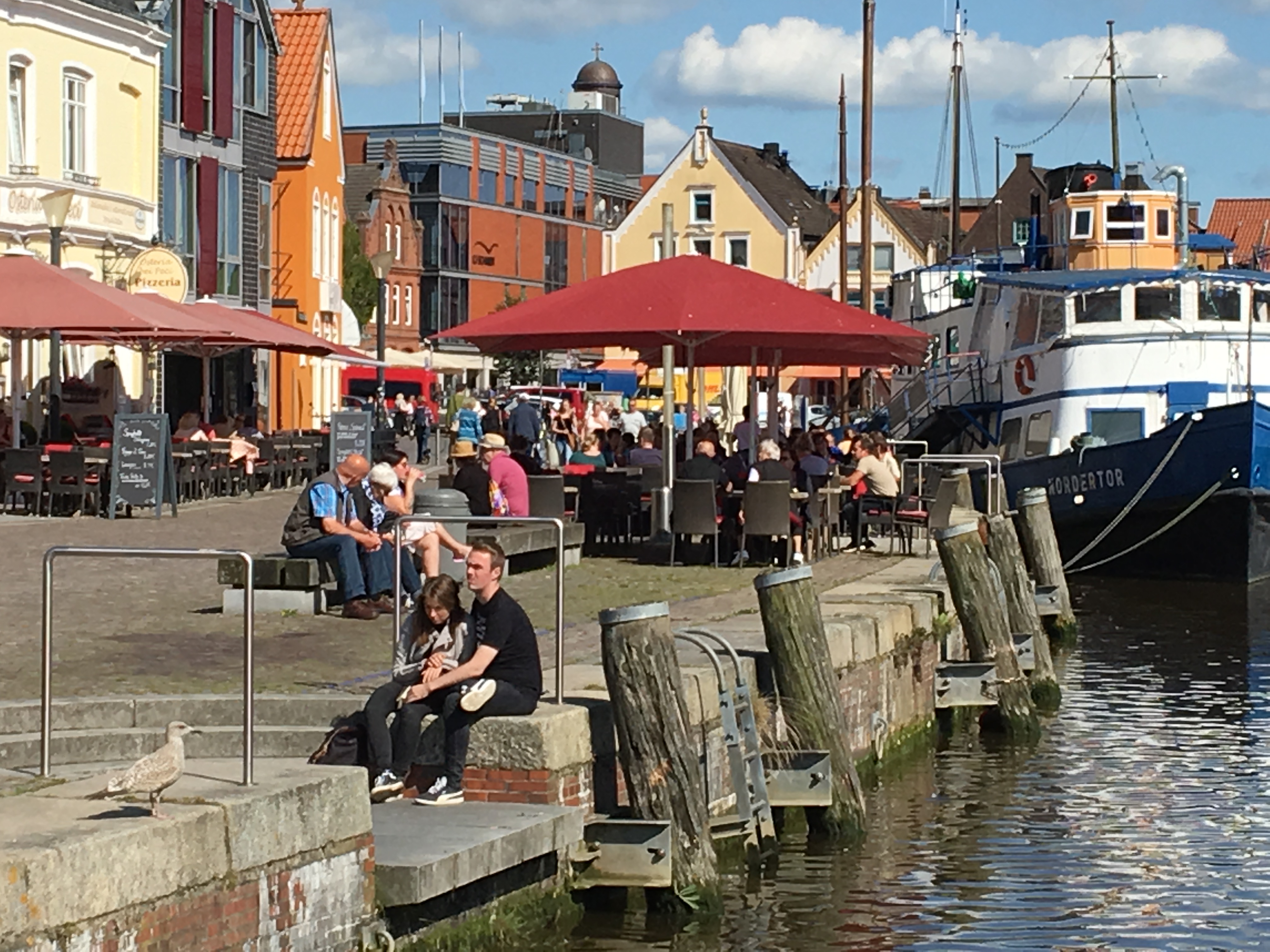 As we had visited Hamburg in 2015 (see also From Utrecht to Hamburg), we decided to pass by this major German port city and head to Husum, a maritime town on the North Sea.
As we had visited Hamburg in 2015 (see also From Utrecht to Hamburg), we decided to pass by this major German port city and head to Husum, a maritime town on the North Sea.
While having a delicious lunch in one of the many waterside bistros, we enjoyed watching the comings and goings in the little harbor.
We knew that Husum was the birthplace of the novelist Theodor Storm. The Theodor Storm House gave us much information about the life of this lawyer-novelist, who is best known for the last of his 50 novellas, “Der Schimmelreiter” (The Rider on the White Horse).
The novel's setting along the North German coast creates an eerie atmosphere along the dyke, with descriptions of superstitions, class differences, and men's struggles against the sea.
Storm's House also gave us a glimpse of the political events in the 19th 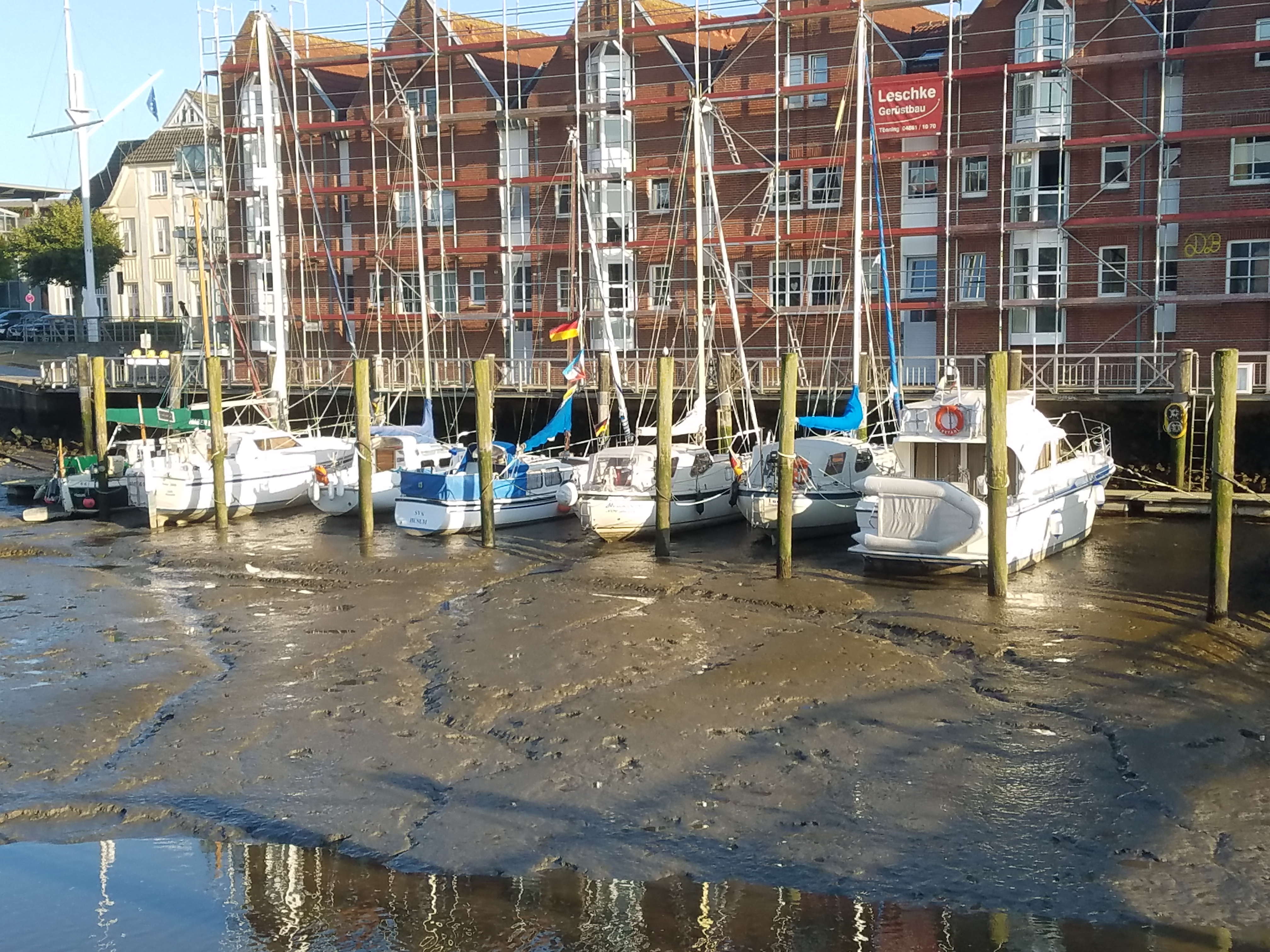 century, as this part of Germany was also under Danish control for a while.
century, as this part of Germany was also under Danish control for a while.
(Today the Danish minority in Husum is represented by its own party [Südschleswigscher Wählerverband, SSW] In the 2017 state elections that party only achieved 3.3%, but is excepted from the 5% minimum and sends three representatives to the Schleswig Holstein Legislature.)
When we came back from out visit to the Storm House, we could see first hand how the considerable tides can maroon boats and ships in the harbor's mud. To get in and out of their slip, these sailor certainly have to consult their tide tables! (see picture above.)
Vocabulary for Travelers 2
der Hafen – the harbor
die Gezeiten – the tides
die Ebbe – the ebb tide
die Flut – the flood tide
der Schlamm – the mud
der Deich – the dike, levee
der Schriftsteller - the writer
der Roman - the novel
der Schimmel – the white horse
die Schleuse – the lock
The Island of Sylt
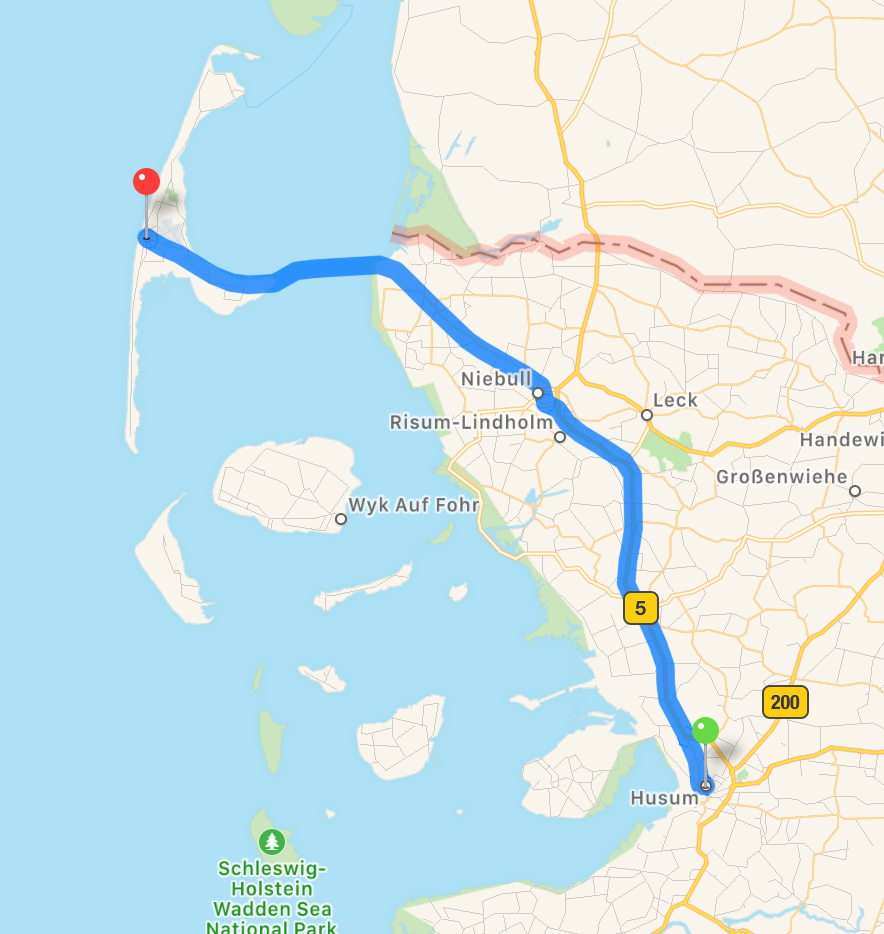 Maybe you've heard of Sylt – the northernmost German and largest North Frisian island in the North Sea.
Maybe you've heard of Sylt – the northernmost German and largest North Frisian island in the North Sea.
The writer Thomas Mann, the actress Marlene Dietrich, and other well-known writers and artists had “discovered” the island already in the 1920s; in the 1970s, playboy Gunther Sachs put it back on the map with his wild parties. The island began to attract the German industrial elite, and famous athletes and movie stars began to rent or build homes there for the summer season.
Today, Sylt has become one of Germany's most popular holiday destinations, the wild times of the 70s just a memory of the past. We wanted to see for ourselves what brings so many visitors to the island.
There are two ways to get to Sylt.: (1) by boat or ferry from the Danish port of Havneby on the island of Romo, or (2) by train across the Hindenburgdam (a causeway named after German President Hindenburg). We chose the latter, drove our rental car unto the train shuttle in Niebull, and 45 minutes later we drove off the train in Westerland, the main town on Sylt.
The island has a 25 mile long beach on the western side, with mudflats towards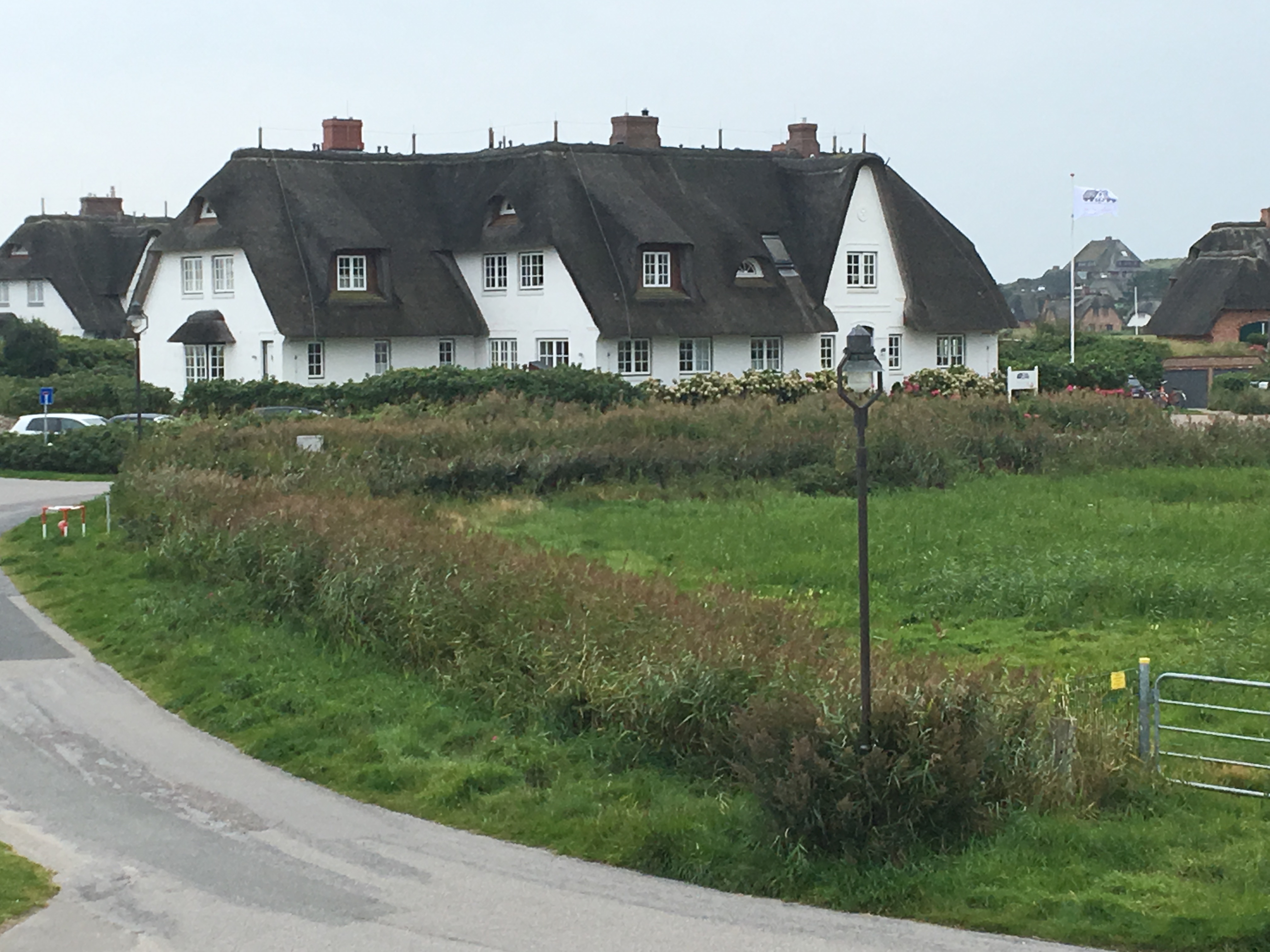 the mainland on the east. We had booked ourselves for 2 days into a B&B in Rantum, just 5 miles south of Westerland (see picture right).
the mainland on the east. We had booked ourselves for 2 days into a B&B in Rantum, just 5 miles south of Westerland (see picture right).
The first evening, we attended an entertaining and informative lecture about Sylt's history of storms. The speaker talked about the many attempts of the islanders to prevent beach erosions and about their continuing struggle against the sea.
Great efforts are taken to prevent the loss of cliffs and dunes during storms. The beaches are replenished with sand dredged up offshore, but storms and tides often counteract all human efforts.
While Westerland is a busy city with many hotels and a very active nightlife, we preferred the calmer and more scenic areas north and south.
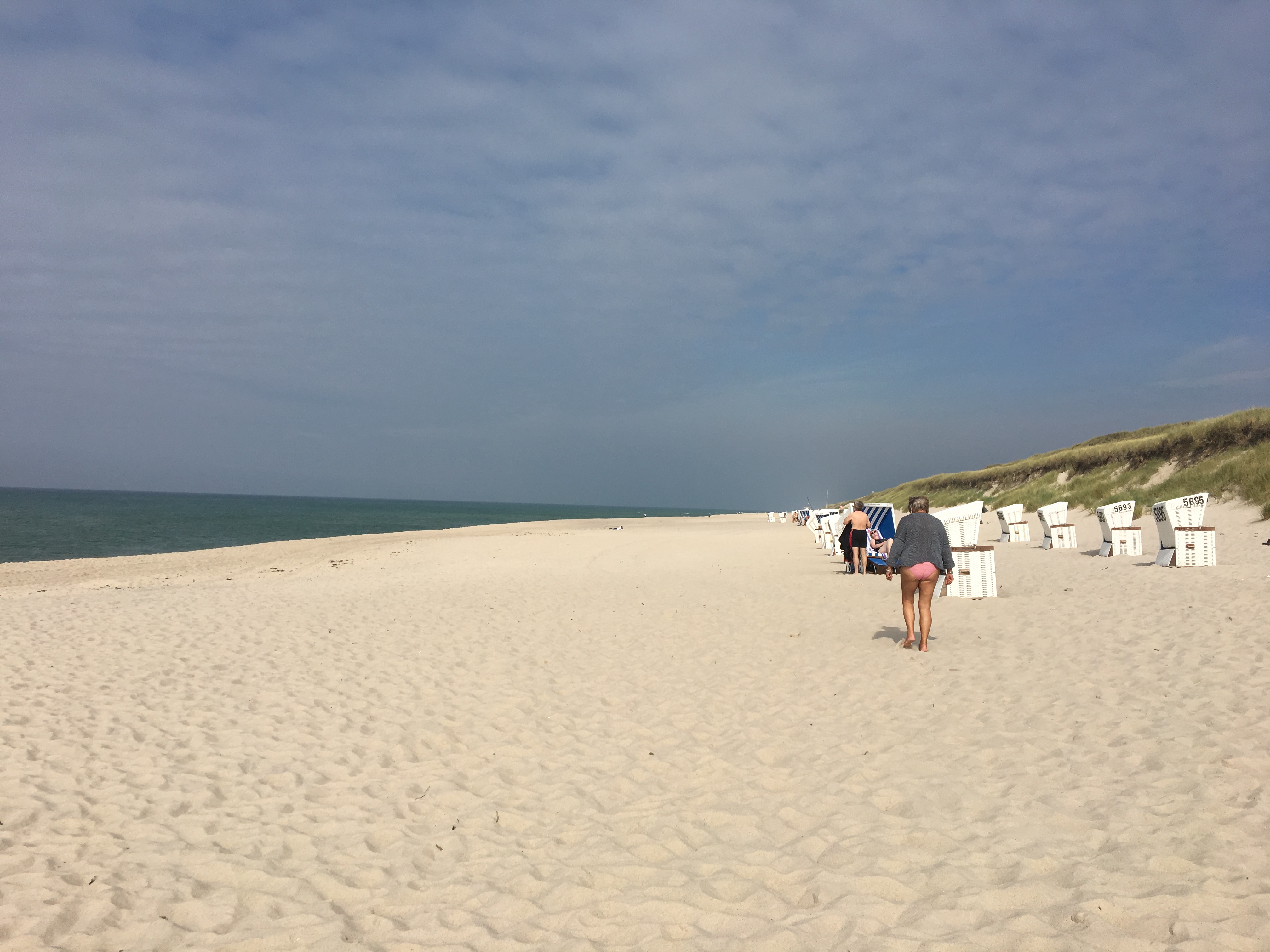 And, if you were wondering – just in case you've heard about Sylt's nude beaches – yes, there are many “FKK” (Freikörperkultur) - “clothing optional” beaches on Sylt. “Buhne 16“, is the oldest and, arguably, the most well-known one. It achieved notoriety during the wild 70s and became a paparazzi hunting ground. (There's also a bistro called Buhne 16.)
And, if you were wondering – just in case you've heard about Sylt's nude beaches – yes, there are many “FKK” (Freikörperkultur) - “clothing optional” beaches on Sylt. “Buhne 16“, is the oldest and, arguably, the most well-known one. It achieved notoriety during the wild 70s and became a paparazzi hunting ground. (There's also a bistro called Buhne 16.)
We explored both the northern and southern tips of the island, walked the long beaches and admired the many wonderful reed-roof houses on the island's high dunes and cliffs.
During our week-day visit in early September, the beaches were mostly empty (see picture above). The large parking lots behind the dunes, however, left no doubt that high-season traffic on the north-south road must be intense.
Vocabulary for Travelers 3
• die Insel - the island
• die Nordseeküste - the coast of the North Sea
• der Landverlust - the loss of land, land erosion
• der Playboy, Lebemann - the playboy
• berühmte Sportler - famous athletes
• der Filmstar - the movie star
• das Ferienziel - the holiday destination
• der Strand - the beach
• die Buhne - the breakwater
• das Watt - the mudflat
• der Vortrag - the lecture
• das Schilfdach - the reed roof
The local language spoken on Sylt is Söl'ring, one of the dialects of North Frisian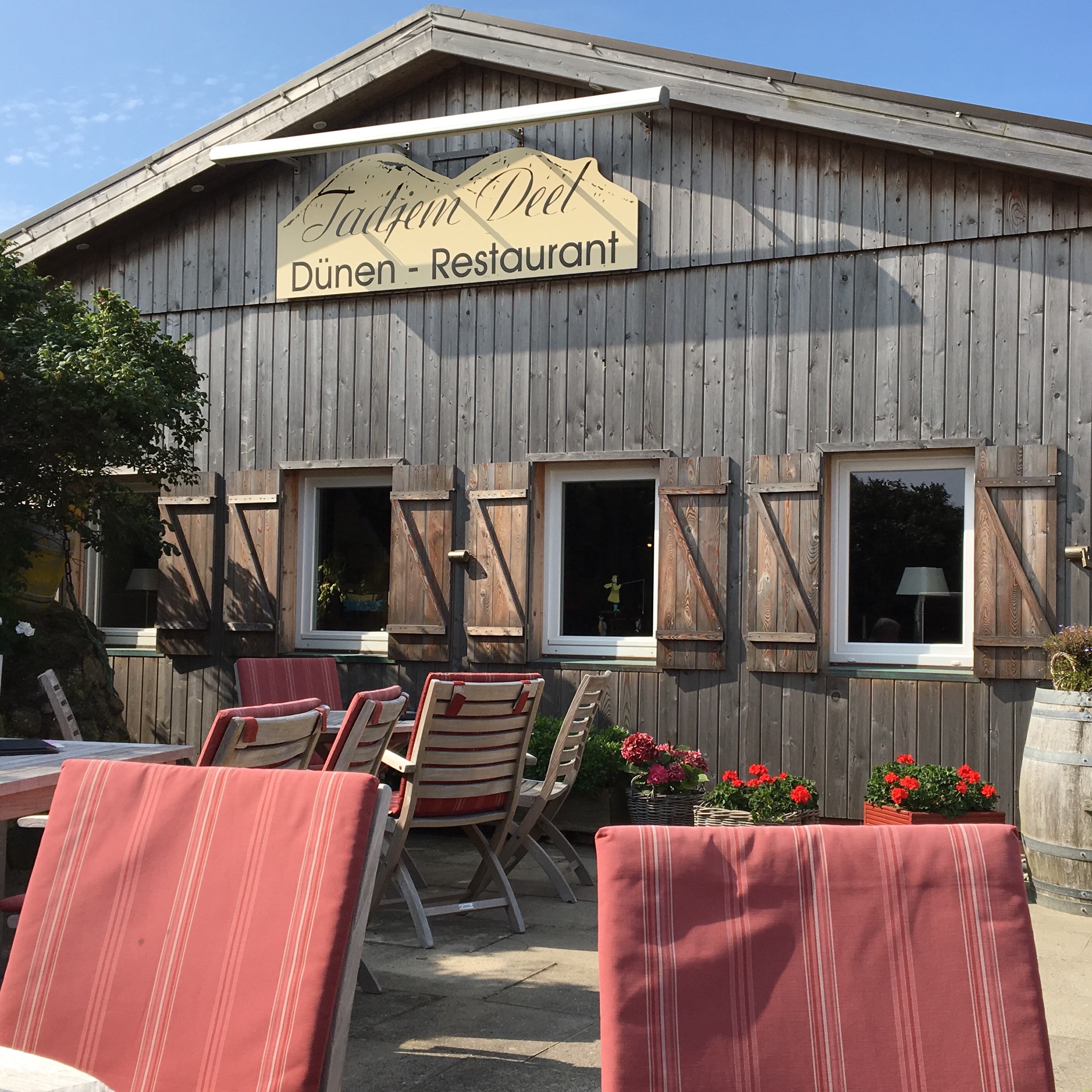 (a Germanic language). Söl'ring, which has been heavily influenced by Danish, is taught in a few elementary schoolson Sylt. However only a few hundred people speak it and we saw Söl'ring only on a couple of signs.
(a Germanic language). Söl'ring, which has been heavily influenced by Danish, is taught in a few elementary schoolson Sylt. However only a few hundred people speak it and we saw Söl'ring only on a couple of signs.
For example, we were puzzled by the name of this restaurant that we found nestled in the dunes (see picture right): “Tadjem Deel”. The owner told us that it means “Küsse Tal” or valley of kisses
After getting a glimpse of one of Germany's most popular vacation spots, Sylt, we set our sights on Denmark. We were eager to try out our Danish, which we had practiced daily for nearly four months on Duolingo.
More about that in one of our next posts.
Bio: Ulrike & Peter Rettig are co-founders of Gamesforlanguage.com. They are lifelong language learners, growing up in several European countries before moving to Canada and the United States. You can follow them on Facebook, Twitter and Instagram, and leave any comments with contact.
